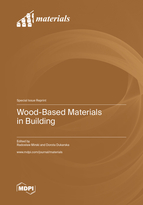Wood-Based Materials in Building
A special issue of Materials (ISSN 1996-1944). This special issue belongs to the section "Construction and Building Materials".
Deadline for manuscript submissions: closed (10 December 2022) | Viewed by 17397
Special Issue Editors
Interests: structural elements; mechanics; glulam beams; engineered wood products; construction; timber evaluation
Special Issues, Collections and Topics in MDPI journals
Interests: wood sciences and technology; wood-based materials; lignocellulosic composites; adhesives; adhesives modification; bio-based adhesives; formaldehyde emission; construction and insulation wood-based materials; PUR foams
Special Issues, Collections and Topics in MDPI journals
Special Issue Information
Dear Colleagues,
Wood is one of the oldest building materials. However, apart from its indisputable advantages, it has numerous disadvantages which limit its use in building construction and in the production of interior design elements. The introduction of modern technological solutions has led to the elimination of the disadvantages of wood and the resulting limitations to its application, through the use of wood-based materials. Their mechanical strength and resistance to moisture—and thus dimensional stability—are often greater than those of the wood from which they are made. In traditional construction, constructional timber components made of solid timber are limited by the dimensions and quality of the raw materials. With new-generation wood-based materials such as engineered wood products (EWPs), it is possible to achieve beam and board dimensions that are not achievable with solid timber. Another important advantage of wood-based materials is the possibility of designing their properties at the production stage, which makes these materials more functional than solid timber. They are increasingly used in timber construction, masonry construction and hybrid construction, which is a compilation of these two technologies. They are used as structural, insulating and auxiliary materials, mainly in the production of interior design elements. New construction systems with a high degree of prefabrication are also based on this type of material. An important advantage of wood-based materials is that lower-quality or small-sized raw materials can be used for their production. All this makes the use of wood-based materials in construction compatible with the idea of sustainable construction, which promotes materials that are as natural as possible and at the same time provide structures with adequate strength, durability and thermal and acoustic comfort. For these reasons, wood-based materials are the subject of numerous studies on the rational use of wood or alternative raw materials; the use of new binding agents in their production; their strength, durability and resistance to biotic and abiotic factors; hygiene; ways of finishing their surfaces and the possibility of producing hybrid materials with their participation.
The aim of this Special Issue is to present current trends and the current state of knowledge in the manufacture and properties of new and innovative wood-based materials for use in the construction industry.
The topics of interest include the following:
- Innovative construction with wood-based materials.
- Thermal and acoustic insulation materials based on wood and non-wood lignocellulosic raw materials.
- The influence of various material and environmental factors on the physical and mechanical properties of constructional wood-based materials.
- Formaldehyde and VOC emissions from wood-based materials used in building structures and interior fittings.
- Hybrid composite materials based on wood and wood-based materials.
- Building systems of wood and wood-based materials.
- Wooden joinery.
- Fire safety and durability of modern wood-based constructions.
We look forward to receiving your contributions.
With kind regards,
Dr. Radosław Mirski
Dr. Dorota Dukarska
Guest Editors
Manuscript Submission Information
Manuscripts should be submitted online at www.mdpi.com by registering and logging in to this website. Once you are registered, click here to go to the submission form. Manuscripts can be submitted until the deadline. All submissions that pass pre-check are peer-reviewed. Accepted papers will be published continuously in the journal (as soon as accepted) and will be listed together on the special issue website. Research articles, review articles as well as short communications are invited. For planned papers, a title and short abstract (about 100 words) can be sent to the Editorial Office for announcement on this website.
Submitted manuscripts should not have been published previously, nor be under consideration for publication elsewhere (except conference proceedings papers). All manuscripts are thoroughly refereed through a single-blind peer-review process. A guide for authors and other relevant information for submission of manuscripts is available on the Instructions for Authors page. Materials is an international peer-reviewed open access semimonthly journal published by MDPI.
Please visit the Instructions for Authors page before submitting a manuscript. The Article Processing Charge (APC) for publication in this open access journal is 2600 CHF (Swiss Francs). Submitted papers should be well formatted and use good English. Authors may use MDPI's English editing service prior to publication or during author revisions.
Keywords
- sustainable construction
- building systems
- construction wood-based materials
- insulation materials
- hybrid composite materials
- wooden joinery
- mechanical properties
- thermal properties
- durability
- hygienic







